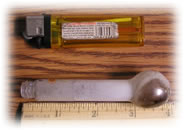 Meth pipes may be homemade or commercially
produced. Pipes consist of a heating chamber and a tube through which the meth vapors are inhaled.
Meth pipes may be homemade or commercially
produced. Pipes consist of a heating chamber and a tube through which the meth vapors are inhaled. - Additional photos of paraphernalia can be seen at the KCI The Anti-Meth site.
Methamphetamine Paraphernalia
Acute care nurses need to be able to recognize drug paraphernalia. Patients may bring paraphernalia when admitted to acute care facilities. Possession of paraphernalia should trigger related health assessment and an appropriate hazardous materials response to prevent the exposure of health workers.
 Meth pipes may be homemade or commercially
produced. Pipes consist of a heating chamber and a tube through which the meth vapors are inhaled.
Meth pipes may be homemade or commercially
produced. Pipes consist of a heating chamber and a tube through which the meth vapors are inhaled. Visiting nurses, community health nurses and first responders need to be able to recognize both paraphernalia and indications of Meth manufacturing. Many of the substances involved in Meth production are hazardous. Exit ASAP!
Chemicals: may include: alcohol, ether, benzene, red phosphorous, iodine, acetone, paint thinner, camp stove fuel, heet, ammonia, lye, drano, hydrochloric acid, battery acid, muriatic acid, propane cylinders, ephedrine, bronchodilators, , methylamine hydrochloride, chloromethane, phenylalanine, sodium borohydride, .
Equipment: propane cylinders, hydrogen cylinder, lithuim batteries, large eyedroppers, scale, small glass bottles, large glass or ceramic bowls, coffee filters, small jars with tops, pyrex baking dish, glass test tubes, lab glassware, rubber gloves,
Signs of a Meth Lab
What To Do If You Encounter a Clandestine Meth Lab
Source: United States Drug Enforcement Administration (2007) http://www.usdoj.gov/dea/concern/methlab_whattodo.html
©RnCeus.com